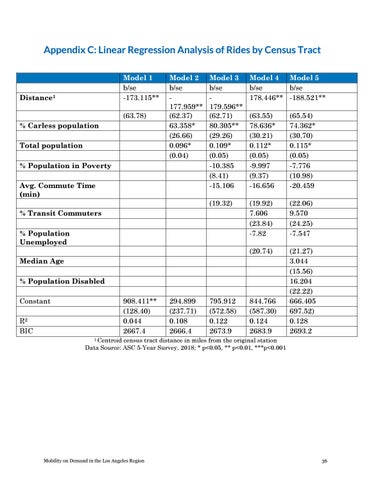Appendix C: Linear Regression Analysis of Rides by Census Tract Model 1 b/se -173.115**
Distance1
(63.78) % Carless population Total population
Model 2 b/se 177.959** (62.37) 63.358* (26.66) 0.096* (0.04)
% Population in Poverty Avg. Commute Time (min)
Model 3 b/se 179.596** (62.71) 80.305** (29.26) 0.109* (0.05) -10.385 (8.41) -15.106
Model 4 Model 5 b/se b/se 178.446** -188.521** (63.55) 78.636* (30.21) 0.112* (0.05) -9.997 (9.37) -16.656
(65.54) 74.362* (30.70) 0.115* (0.05) -7.776 (10.98) -20.459
(19.32)
(19.92) 7.606 (23.84) -7.82
(22.06) 9.570 (24.25) -7.547
(20.74)
(21.27) 3.044 (15.56) 16.204 (22.22) 666.405 697.52) 0.128 2693.2
% Transit Commuters % Population Unemployed Median Age % Population Disabled Constant
908.411** (128.40) 0.044 2667.4
R2 BIC
294.899 (237.71) 0.108 2666.4
795.912 (572.58) 0.122 2673.9
844.766 (587.30) 0.124 2683.9
1 Centroid
census tract distance in miles from the original station Data Source: ASC 5-Year Survey, 2018; * p<0.05, ** p<0.01, ***p<0.001
Mobility on Demand in the Los Angeles Region
36



